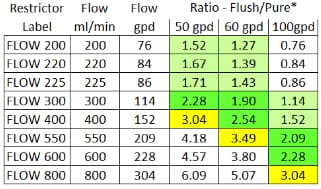People sometimes get concerned that reverse osmosis (RO) systems are wasteful of water, and ask about possibly using the RO flush water for other plants. Let’s start with a brief overview of the operation of an RO system.

After passing through the sediment and carbon prefilters, the raw water enters the membrane housing in the center of the cap. Water pressure within the housing – created by the flow restrictor in the flush water line, pushes water through the membrane, which allows only the pure water to pass, which exits through the pure water outlet.
The relative amounts of pure and flush water produced are determined by several factors – the rating of the membrane, the flow restrictor, and the incoming pressure & temperature of the incoming, raw water. Some typical values are below:

Let’s now look at using the RO flush water, using a “Counter-Top Reverse Osmosis” system as an example, which is outfitted with a 50 gpd membrane and FLOW 220 restrictor. Using the chart above, we see that the Flush-to-Pure ratio is 1.67. That means that every 2.67 gallons of raw water entering the system is converted into 1 gallon of purified water and 1.67 gallons of flush water.
All of the dissolved solids in the raw water have been concentrated in the flush water by the membrane, so we can easily determine the dissolved solids content of that flush water, with a simple calculation:
Flush Water TDS = Raw Water TDS x (1+Ratio) ÷ Ratio
So, if our incoming, raw water has a true dissolved solids content of 175 ppm and is at 25 psi and 77°F (the rating parameters for that low-pressure membrane), then our flush water has a true dissolved solids content of 175 x (2.67/1.67) = 280 ppm, which is well within the acceptable range for almost any, less-sensitive plant, such as those in flower beds, vegetable gardens and turf.